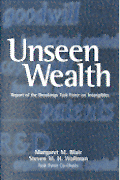This article originally appeared in the July-August Issue of Harvard Business Review.
Each year most public companies issue reports on the pay packages of their top executives, describing how their compensation committees arrived at the numbers. These reports are part of the proxy statements sent to all shareholders, who vote on the packages. The votes are advisory or binding, depending on the country where a company is chartered.
More than 95% of the time, shareholders overwhelmingly approve the pay recommendations. Yet our research suggests that investors should be more skeptical. Compensation committees frequently adjust company performance numbers in complex and even obscure ways, for a variety of reasons. Sometimes, for example, they want to focus on the performance of a company’s core or continuing operations. Whatever the motive, the upshot is all too often inflated numbers, calculated on a nonstandard basis, that rationalize overly generous compensation.
Given that reality, compensation committees need to explain the basis of their decisions more clearly in their reports. For their part, investors need to develop standards and best practices for compensation design and reporting, around which they can build a meaningful dialogue with companies. Such a dialogue is critical today in view of the public’s concerns over the rising ratio of CEO pay to the average worker’s wages and of shareholders’ growing insistence that high pay be justified by superior managerial performance.
In this article we’ll review the common shortcomings of compensation committee reports, especially the use of nonstandard accounting measures and the selection of inappropriate peer companies. We’ll also propose ways in which companies and shareholders can improve their approach to determining top management’s compensation. Let’s begin by looking at an example of the problem.
Generous to a fault
In their reports, most compensation committees identify the criteria used to award both annual cash bonuses and longer-term stock grants—usually the two largest components of executive pay. But even at the most upstanding companies, those criteria are seldom well explained.
Take the 2015 compensation committee report of a well-known Fortune 500 company (which you’ll find summarized above in the exhibit “One CEO’s Pay Package”). Running 15 single-spaced pages, it makes a serious effort to delineate the components of the $24 million this CEO received for the year and the criteria behind them. But, like most such reports, it doesn’t provide enough information to allow the reader to make an informed judgment on the merits of the pay package without doing a lot of extra work. So we dug a bit deeper:
The cash bonus
The committee tied 40% of this to a revenue target and 20% to a goal for the company’s product pipeline. Its report provides clear numbers for the revenue target and specific milestones for the pipeline.
But shareholders would struggle to understand the criterion for the other 40% of the bonus: non-GAAP EPS, or earnings per share calculated on a basis other than generally accepted accounting principles. Companies often use such earnings figures, arguing that GAAP numbers don’t provide a fair picture of performance.
Let’s examine that a little. The report discloses that the CEO’s goal for 2015 was a non-GAAP EPS of $3.40 a share and describes in general terms the categories of GAAP expenses that were excluded in arriving at that number. The committee concluded that the company’s non-GAAP EPS for 2015 was $3.59, which was adjusted down to $3.56 to eliminate currency effects. According to those numbers, the CEO exceeded his goal by 16 cents a share.
What the report doesn’t make clear is the considerable disparity between the company’s GAAP and non-GAAP earnings. Instead, a footnote refers the reader to the company’s 10-K report. There the curious reader learns that this difference is approximately $7.5 billion, which constitutes more than 100% of this company’s GAAP earnings for 2015. In plain English, the company’s earnings under GAAP were $1.56 a share, versus $3.56 under the non-GAAP criterion used by the committee.
Why such a big difference? A review of the 10-K reveals that most of it came from eliminating charges for acquisition and divestiture costs in 2015 and earlier years. While that move may have helped the committee focus on the continuing business, the reader has no good way to evaluate whether the huge costs of these transactions were outweighed by their benefits.
In addition, the non-GAAP earnings exclude a charge of $680 million for settling litigation that began when the current CEO was the company’s general counsel. The report, however, makes no attempt to distinguish between litigation charges related to decisions made by the current CEO and those for which he did not have responsibility.
Long-term incentives
The compensation committee based 50% of the CEO’s grant of stock and options on “adjusted operating cash flow.” This term is not explained in the company’s proxy statement for 2015. All we could find is an exhibit in the company’s 10-K providing the following definition:
“Adjusted Operating Cash Flow” means the Company’s after-tax non-GAAP income (attributable to the Company) less the change in working capital (working capital includes Trade Accounts Receivables and Inventory—including Trade Accounts Receivables and Inventory included in Other Assets—net of Accounts Payable) plus non-GAAP depreciation and amortization for each calendar year of the Award Period.
We could not find any quantification of adjusted operating cash flow in the proxy statement or the company’s 10-K for 2015. So it would be extremely difficult for any shareholder to understand the implications of relying on this complex definition.
The other 50% of the long-term incentive award was tied to total shareholder return over the previous three years. TSR is the increase or decrease in share price plus dividends, and the report compares the company’s annualized TSR to that of 11 peers—an appropriate group of large international companies.
This comparison shows that the company’s annualized TSR was 10.6%—lower than that of nine of its peers, whose TSRs ranged from 12.4% to 32.2%. Although the report notes that the company’s annualized TSR ranked 10th in the peer group of 12, the committee awarded the CEO 80% of his target payout on this measure. The only explanation in the report is a small chart showing that the payout was set by the committee at 80% if the company’s TSR came in 10th, 11th, or 12th in the peer group.
Reasonable investors might ask why the CEO should get a large award for such lackluster performance. To give him 80% of his payout for a TSR in the lowest quartile of the firm’s peers does not seem to qualify as pay for performance. In our view, if a company’s TSR ranks in the lower half of its peer group, its CEO should receive less than half the base payout.
What would have been reasonable compensation for this CEO? To estimate that, we applied the model described by John Core, Wayne Guay, and David Larcker in their 2008 Journal of Financial Economics article “The Power of the Pen and Executive Compensation.” Although regression-based models typically aren’t used by companies and their consultants, the one Core, Guay, and Larcker proposed is the most academically reputable way to calculate appropriate CEO compensation. Its main inputs are the firm’s TSR, revenue, and GAAP earnings; the length of the CEO’s tenure; and the ratio of the company’s book to market value. This model indicates that the CEO should have received total compensation of roughly $12 million—half what he actually got.
Mind the GAAP
The company used as our example is by no means the only one to make big adjustments to GAAP earnings. In 2015, 36 companies in the S&P 500 announced adjusted earnings that were more than 100% higher than their GAAP income, and another 57 announced adjusted earnings that were 50% to 100% higher.
All told, roughly two-thirds of S&P 500 companies reported adjusted earnings exceeding their GAAP income in 2015. And most compensation committees in firms with substantial differences between GAAP and non-GAAP numbers used the non-GAAP ones to set CEO pay. At those companies adjusted earnings or adjusted operating cash flow determined at least 40% of either annual cash bonuses or long-term stock awards, or both.
To be sure, there are often good reasons for adjusting GAAP figures. But a more nuanced analysis suggests that in many cases, compensation committees are too quick to exclude certain items or make inconsistent exclusions. Let’s review the GAAP expense items most commonly involved:
External events.
Compensation committees often exclude items related to events beyond management’s control, and this is usually a reasonable practice. The best illustration is a shift in currency values. Committees legitimately factor these out so that they can compare this year’s income to last year’s on a constant currency basis. To be credible, however, a compensation committee should be evenhanded, excluding the upside as well as the downside. For example, many compensation committees at energy companies excluded losses due to the sharp drop in oil prices in 2015. But in earlier years few of them excluded windfall gains from high oil prices.
Extraordinary or nonrecurring expenses.
Compensation committees typically exclude onetime losses associated with extraordinary events—such as restructuring costs after acquisitions. But they also omit onetime losses resulting from poor management or executive misbehavior, such as plant closures for safety reasons or legal settlements for alleged misstatements. Indeed, management has considerable discretion in deciding what items will be labeled extraordinary or nonrecurring. An overwhelming majority tend to be losses, and their recurrence is not so infrequent. (For more on that practice, see “Do Stock Prices Fully Reflect the Implications of Special Items for Future Earnings?” by David Burgstahler, James Jiambalvo, and Terry Shevlin, Journal of Accounting Research, 2002.)
Taxes and interest.
Some committees exclude interest and taxes when calculating non-GAAP earnings. The typical rationale is that these items represent fiscally mandated charges, not operating expenses. But much of the money companies borrow goes into plant and equipment needed to produce goods and services. Moreover, efficient management of financing and taxes is directly relevant to the functions of the CFO and other executives.
Noncash expenses.
Compensation committees may also exclude depreciation and amortization on the grounds that they aren’t operating expenses. But this argument is thin: Both types of expenses represent the economic wear and tear on plant and equipment involved in generating operating income on an annual basis. Still other compensation committees exclude depreciation and amortization because they’re noncash subtractions. Yet both these items represent the actual future investment required for rebuilding or replacing tangible or intangible property.
Stock grants and options.
In our view the most problematic exclusions are expenses for grants of restricted shares or stock options. The Financial Accounting Standards Board, after years of extensive discussions, has ruled that these expenses should be included in calculating GAAP net income. So it is questionable for a compensation committee to undermine this accounting rule. The impact of this expense can be considerable.
LinkedIn provides a good illustration of the problem. A company press release projected that the firm would have adjusted earnings of $950 million for calendar year 2015. The accompanying table revealed that under GAAP the company’s net income would be minus $240 million. The biggest reason for the difference was the exclusion of $630 million in GAAP expenses for stock options and restricted shares awarded to the company’s top executives. We fundamentally question whether it’s legitimate for compensation committees to use a criterion for CEO compensation that excludes large expenses for awards they themselves have granted to the CEO.
Given the lack of uniform definitions for non-GAAP measures, most shareholders cannot understand the amounts involved in GAAP adjustments simply by reading compensation committee reports. Though the reports typically describe the adjustments in general terms, they usually do not quantify the differences between GAAP and non-GAAP figures. Instead, they refer readers to the company’s 10-K—a large and complex filing that is hard to digest.
TSR: Relative to What?
The Fortune 500 company’s overly generous treatment of weak performance on relative TSR is not an isolated case. Although CEO compensation is indeed higher for superior-TSR firms and lower for inferior-TSR firms over extended time periods, empirical evidence demonstrates that the difference is skewed: CEOs get large rewards for outperforming a peer group’s average but modest penalties for underperformance.
Much of the problem stems from the choice of peers. The typical compensation committee compares the TSR of its own company with the TSRs of its peers over the previous three years as well as the current pay packages for its top executives with those of its peers. To provide a fair comparison, the peer group should consist of companies with similar revenues and market capitalizations and from similar industries. A biased peer group totally undermines its utility in setting compensation.
Unfortunately, the peer groups of many firms are packed with much larger enterprises, in order to provide a high benchmark for compensation comparisons. In 2010 the IRRC Institute found that S&P 500 companies with high CEO pay, relative to that at companies of similar size, were 25% smaller than their self-selected peers by revenue and 45% smaller by market capitalization. A study of the 2015 proxy statements of companies in the Russell 3000 found that they most frequently chose as peers 13 large manufacturers, such as 3M and Honeywell. But most companies in the Russell 3000 are not primarily engaged in manufacturing and are considerably smaller than such huge companies.
One office-supplies company we examined illustrates the point well. It reported revenue of $13 billion for 2015 and a market capitalization of $2.6 billion at the end of that year. But the 20 companies in the peer group the compensation committee chose all had higher market capitalizations, and eight of the 20 had market caps above $10 billion. Thirteen had higher revenues. Moreover, several of the larger companies in the group were outside the business of office supplies.
To mitigate bias in the composition of peer groups, we urge every compensation committee to choose comparison companies before the start of the period for measuring TSR rather than at the end, as now often happens. Before the start date, the committee would not know the TSR or CEO pay of any peers. In addition, the SEC should require the committee report to disclose the market capitalizations, revenues, and industry codes of all companies in the peer group.
To be fair, the SEC has made efforts to highlight the relationship between CEO compensation and TSR: In 2015 it proposed that the compensation committee report include a graph mapping the company’s TSR over the prior five years against the compensation of its CEO in each of those years. Such a graph would be helpful because it would extend the typical measurement period from three to five years, but it would still highlight only the performance of the company. So we think the report should also include a table listing, from highest to lowest, the annualized TSR of the company and its peers over the five years. That move would help the committee and shareholders align the CEO’s stock awards more closely with the firm’s relative TSR.
Creating a Constructive Dialogue
Although large asset managers typically have a unit responsible for recommending proxy votes, it’s usually small and hard-pressed to review the more than 1,000 proxies it might be sent during proxy season. Staffers in such units readily admit they lack the time and expertise to conduct in-depth analyses of complex issues like non-GAAP criteria and peer group composition. That’s why most asset managers subscribe to proxy advisory services, such as Institutional Shareholder Services (ISS) and Glass Lewis (GL).
But shareholders should not automatically follow the recommendations of proxy advisers on compensation votes. Take GL, which screens compensation reports against a company’s GAAP financial statements. While GL does in a few cases express concerns about adjustments that it believes are not well justified and that result in much higher payouts, it did not do so with the compensation report of the Fortune 500 company analyzed earlier.
ISS employs relative TSR as its primary screen for compensation reports, using its own methodology for creating peer groups. If this screen reveals serious concerns, ISS will assign a staffer to do an in-depth analysis of the report. However, according to ISS, its screen did not raise any major questions about the report of the company in our example, although the company’s relative TSR was in the lowest quartile of its self-selected peer group.
The bottom line is that even institutional shareholders with subscriptions to proxy advisers don’t have access to the data or the expertise to make a meaningful assessment of the executive pay packages that companies propose.
The bottom line is that even institutional shareholders with subscriptions to proxy advisers don’t have access to the data or the expertise to make a meaningful assessment of the executive pay packages that companies propose. It is incumbent, therefore, on compensation committees, which do have access, to do a better job of explaining their rationales. As we have suggested, more-transparent reporting of GAAP adjustments, preselection of a TSR peer group, and less tolerance for relatively poor TSR performance would be major advances.
But even if compensation committees do take steps to improve their reports, institutional investors still need to set standards and monitor compliance. Instead of relying on proxy advisers, investors should take matters into their own hands. The best way to do so would be to support a U.S. association dedicated to creating long-term corporate value through shareholder engagement on compensation resolutions. It could be formed under the umbrella of an existing association, such as FCLT (Focusing Capital on the Long Term) Global.
The new association could develop and promote a nonbinding set of best practices for compensation committees, which could include very basic guidelines about the use of non-GAAP criteria. The committee at each company would either apply these practices or explain its reason for departing from them. This approach would resemble the model successfully adopted in the UK, where regulators frequently impose rules—such as limits on the tenure of independent directors—but allow a company to deviate from them if it explains why to shareholders.
To further promote engagement, each company should hold a public conference call, a few weeks before its annual meeting, in which compensation committee members explain major variations from the association’s best practices and respond to shareholders’ questions. Pre-vote discussions with large shareholders have prompted companies to revise compensation plans and head off adverse votes on resolutions in the past. (One company we looked at dropped a plan to pay certain taxes for its CEO after such a call.)
As more countries mandate shareholder votes on executive pay, compensation committee reports could play an important role in enhancing the relationship between company boards and shareholders. Properly designed and prepared, these reports could help educate shareholders about the objectives of companies and the ways they measure success. More broadly, clear, unambiguous explanations of how the various components of pay are linked to reasonable metrics of company performance would help the business community respond more effectively to growing public concerns about excessive CEO compensation.
Robert Pozen has been a nonresident senior fellow at Brookings since 2010. In 2015, he generously committed to endow the Director’s Chair for the Urban-Brookings Tax Policy Center. Until 2010, Pozen was executive chairman of MFS Investment Management and, before 2002, served in various positions at Fidelity Investments. He did not receive financial support from any firm or person for this article or from any firm or person with a financial or political interest in this article. He is currently not an officer, director, or board member of any organization with an interest in this article.







